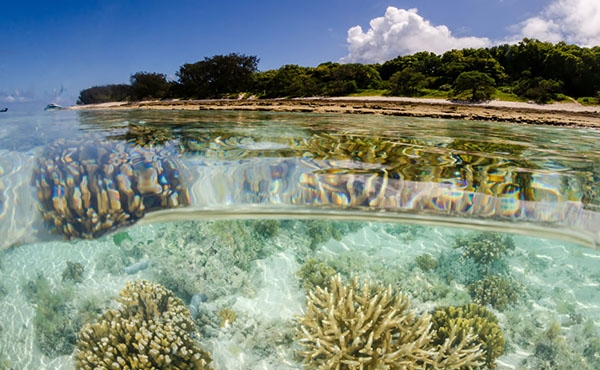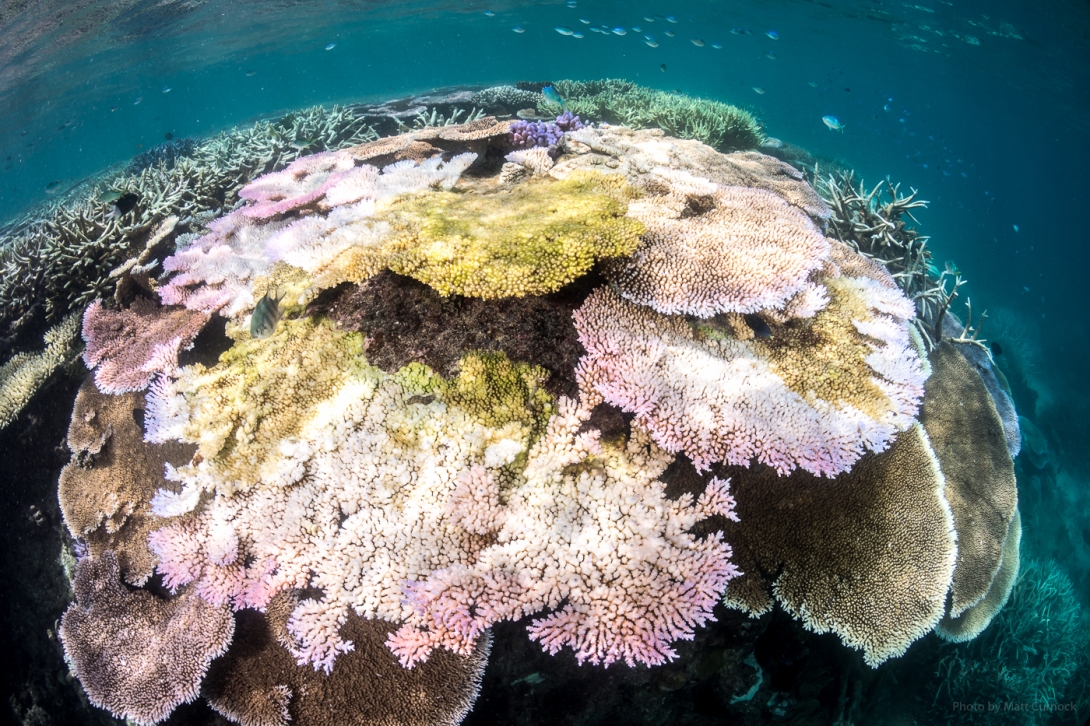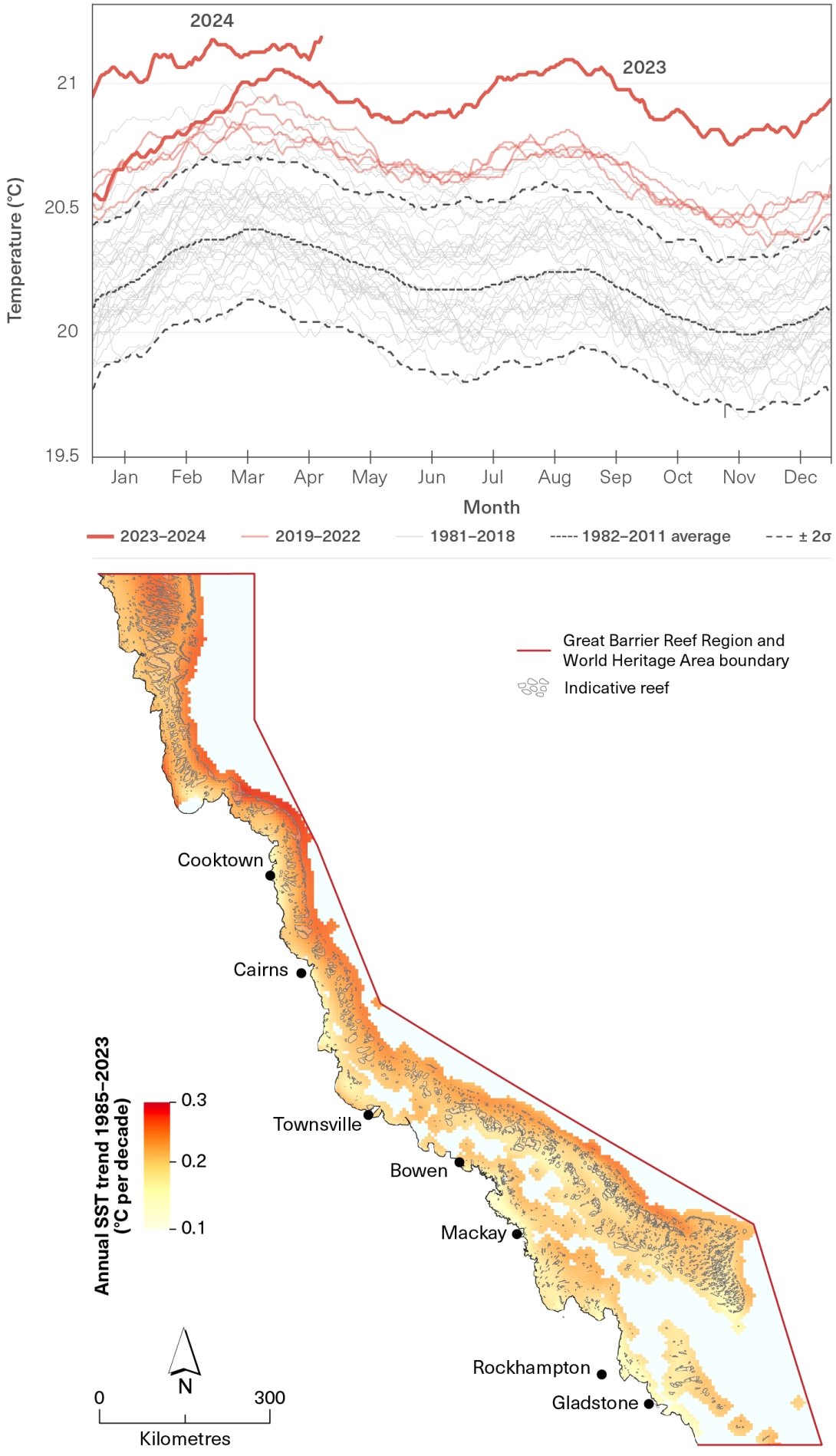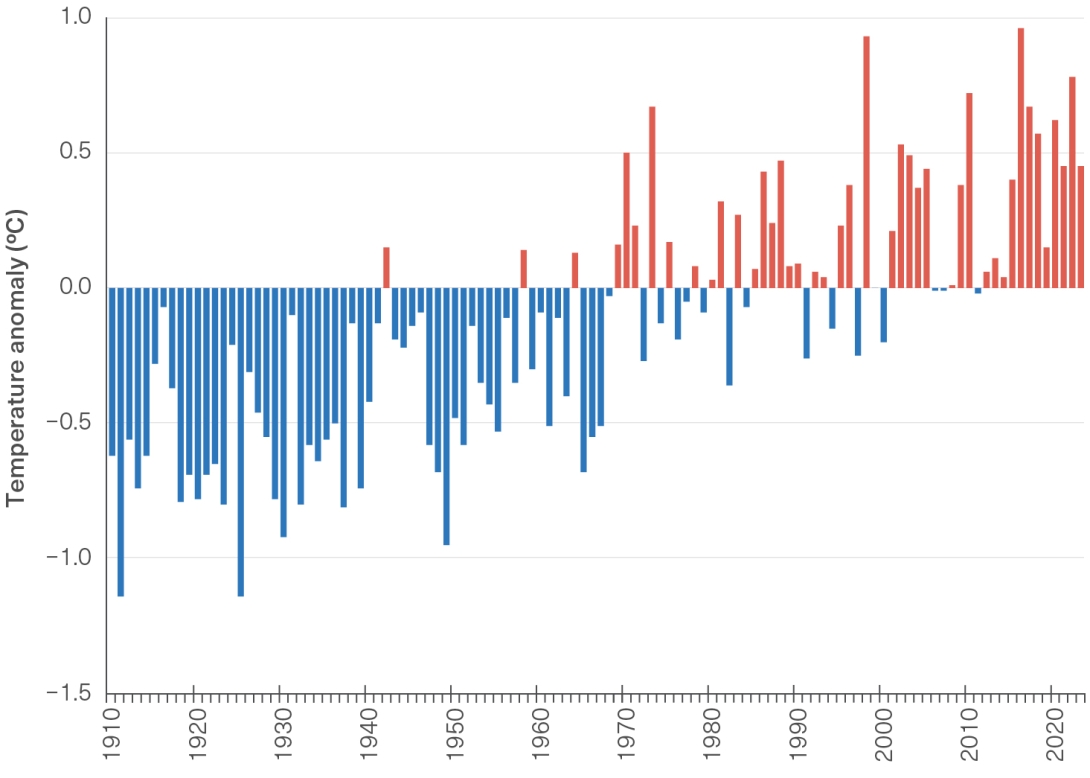158.
Cheung, M.W.M., Hock, K., Skirving, W. and Mumby, P.J. 2018, Cumulative bleaching undermines systemic resilience of the Great Barrier Reef, Marine Ecology Progress Series 604(23): 263-268.
163.
Australian Institute of Marine Science 2023, A pause in recent coral recovery across most of the Great Barrier Reef. Annual summary report of the Great Barrier Reef coral condition 2022/23, Australian Institute of Marine Science, Townsville.
166.
World Meteorological Organization 2024, State of the Global Climate 2023, WMO, Geneva, Switzerland.
180.
McWhorter, J.K., Halloran, P.R., Roff, G. and Mumby, P.J. 2024, Climate change impacts on mesophotic regions of the Great Barrier Reef, Proceedings of the National Academy of Sciences 121(16): e2303336121.
185.
Thompson, A., Davidson, J., Logan, M. and Thompson, C. 2023, Marine Monitoring Program Annual Report for Inshore Coral Reef Monitoring: 2021–22. Report for the Great Barrier Reef Marine Park Authority, Townsville.
246.
Huang, Z., Feng, M., Dalton, S.J. and Carroll, A.G. 2024, Marine heatwaves in the Great Barrier Reef and Coral Sea: their mechanisms and impacts on shallow and mesophotic coral ecosystems, Science of The Total Environment 908: 1-20.
252.
Benthuysen, J.A., Emslie, M.J., Currey-Randall, L.M., Cheal, A.J. and Heupel, M.R. 2022, Oceanographic influences on reef fish assemblages along the Great Barrier Reef, Progress in Oceanography 208: 102901.
330.
Pinsky, M.L., Eikeset, A.M., McCauley, D.J., Payne, J.L. and Sunday, J.M. 2019, Greater vulnerability to warming of marine versus terrestrial ectotherms, Nature 569(7754): 108-111.
333.
Smith, K.E., Burrows, M.T., Hobday, A.J., King, N.G., Moore, P.J., et al. 2023, Biological impacts of marine heatwaves, Annual Review of Marine Science 15: 119-145.
366.
Ceccarelli, D.M., Evans, R.D., Logan, M., Jones, G.P., Puotinen, M., et al. 2023, Physical, biological and anthropogenic drivers of spatial patterns of coral reef fish assemblages at regional and local scales, Science of the Total Environment 904: 166695.
536.
IPCC 2023, Climate Change 2023: Synthesis Report. Contribution of Working Groups I, II and III to the Sixth Assessment Report of the Intergovernmental Panel on Climate Change, eds H. Lee and J. Romero IPCC, Geneva, Switzerland: 184.
540.
CSIRO and The Bureau of Meteorology 2022, State of the Climate 2022.
632.
Wang, C., Deser, C., Yu, J., DiNezio, P. and Clement, A. 2017, El Niño and southern oscillation (ENSO): a review, in Coral reefs of the eastern tropical Pacific: persistence and loss in a dynamic environment, eds P.W. Glynn, D.P. Manzello and I.C. Enochs, Springer, Miami, pp. 85-106.
633.
Hobday, A.J., Burrows, M.T., Filbee-Dexter, K., Holbrook, N.J., Sen Gupta, A., et al. 2023, With the arrival of El Niño, prepare for stronger marine heatwaves, Nature 621(7977): 38-41.
634.
Abram, N.J., Hargreaves, J.A., Wright, N.M., Thirumalai, K., Ummenhofer, C.C., et al. 2020, Palaeoclimate perspectives on the Indian Ocean dipole, Quaternary Science Reviews 237: 106302.
635.
Steinberg, C., Benthuysen, J.A., Klein-Salas, E., Cantin, N.E., Tonin, H., et al. 2021, Oceanographic drivers of bleaching in the GBR: from observations to prediction, Volume 1: Summary of oceanographic conditions during the 2015-17 bleaching years., Report to the National Environmental Science Program. Reef and Rainforest Research Centre Limited, Cairns (52pp.).
636.
Benthuysen, J.A., Smith, G.A., Spillman, C.M. and Steinberg, C.R. 2021, Subseasonal prediction of the 2020 Great Barrier Reef and Coral Sea marine heatwave, Environmental Research Letters 16(12): 124050.
637.
Benthuysen, J.A., Tonin, H., Brinkman, R., Herzfeld, M. and Steinberg, C. 2016, Intrusive upwelling in the central Great Barrier Reef, Journal of Geophysical Research: Oceans 121(11): 8395-8416.
638.
Wijffels, S.E., Beggs, H., Griffin, C., Middleton, J.F., Cahill, M., et al. 2018, A fine spatial-scale sea surface temperature atlas of the Australian regional seas (SSTAARS): seasonal variability and trends around Australasia and New Zealand revisited, Journal of Marine Systems 187: 156-196.
639.
Mahjabin, T., Pattiaratchi, C. and Hetzel, Y. 2020, Occurrence and seasonal variability of Dense Shelf Water Cascades along Australian continental shelves, Scientific Reports 10(1): 9732.
640.
Reid, E.C., Lentz, S.J., DeCarlo, T.M., Cohen, A.L. and Davis, K.A. 2020, Physical processes determine spatial structure in water temperature and residence time on a wide reef flat, Journal of Geophysical Research: Oceans 125(12): e2020JC016543.
641.
Ainsworth, T.D., Leggat, W., Silliman, B.R., Lantz, C.A., Bergman, J.L., et al. 2021, Rebuilding relationships on coral reefs: coral bleaching knowledge‐sharing to aid adaptation planning for reef users: bleaching emergence on reefs demonstrates the need to consider reef scale and accessibility when preparing for, and responding to, coral bleaching, Bioessays 43(9): 2100048.
642.
Pezner, A.K., Courtney, T.A., Barkley, H.C., Chou, W., Chu, H., et al. 2023, Increasing hypoxia on global coral reefs under ocean warming, Nature Climate Change 13(4): 403-409.
643.
Hughes, D.J., Alderdice, R., Cooney, C., Kühl, M., Pernice, M., et al. 2020, Coral reef survival under accelerating ocean deoxygenation, Nature Climate Change 10(4): 296-307.
644.
Oliver, E.C., Donat, M.G., Burrows, M.T., Moore, P.J., Smale, D.A., et al. 2018, Longer and more frequent marine heatwaves over the past century, Nature Communications 9(1): 1-12.
645.
Hobday, A.J., Alexander, L.V., Perkins, S.E., Smale, D.A., Straub, S.C., et al. 2016, A hierarchical approach to defining marine heatwaves, Progress in Oceanography 141: 227-238.
646.
Hobday, A.J., Oliver, E.C., Gupta, A.S., Benthuysen, J.A., Burrows, M.T., et al. 2018, Categorizing and naming marine heatwaves, Oceanography 31(2): 162-173.
647.
Smale, D.A., Wernberg, T., Oliver, E.C., Thomsen, M., Harvey, B.P., et al. 2019, Marine heatwaves threaten global biodiversity and the provision of ecosystem services, Nature Climate Change 9(4): 306-312.
648.
Sinclair, B.J., Marshall, K.E., Sewell, M.A., Levesque, D.L., Willett, C.S., et al. 2016, Can we predict ectotherm responses to climate change using thermal performance curves and body temperatures? Ecology Letters 19(11): 1372-1385.
649.
Schulte, P.M. 2015, The effects of temperature on aerobic metabolism: towards a mechanistic understanding of the responses of ectotherms to a changing environment, The Journal of Experimental Biology 218(12): 1856-1866.
650.
Nguyen, K.D.T., Morley, S.A., Lai, C., Clark, M.S., Tan, K.S., et al. 2011, Upper temperature limits of tropical marine ectotherms: global warming implications, PLoS One 6(12): e29340.
651.
Leggat, W.P., Camp, E.F., Suggett, D.J., Heron, S.F., Fordyce, A.J., et al. 2019, Rapid coral decay is associated with marine heatwave mortality events on reefs, Current Biology 29(16): 2723-2730. e4.
652.
Pratchett, M.S., Heron, S.F., Mellin, C. and Cumming, G.S. 2021, Recurrent mass-bleaching and the potential for ecosystem collapse on Australia’s Great Barrier Reef, in Ecosystem collapse and climate change Springer, pp. 265-289.
653.
van Woesik, R. and Shlesinger, T. 2023, Bleaching of the world's coral reefs, in Biological and Environmental Hazards, Risks, and Disasters, ed. R. Sivanpillai, Elsevier, pp. 251-271.
654.
Dias, M., Ferreira, A., Gouveia, R. and Vinagre, C. 2019, Synergistic effects of warming and lower salinity on the asexual reproduction of reef-forming corals, Ecological Indicators 98: 334-348.
655.
Serrano, O., Arias-Ortiz, A., Duarte, C.M., Kendrick, G.A. and Lavery, P.S. 2021, Impact of marine heatwaves on seagrass ecosystems, in Ecosystem Collapse and Climate Change, eds J.G. Canadell and R.B.Jackson, Springer, Switzerland, pp. 345-364.
656.
Brown, C.J., Mellin, C., Edgar, G.J., Campbell, M.D. and Stuart‐Smith, R.D. 2021, Direct and indirect effects of heatwaves on a coral reef fishery, Global Change Biology 27(6): 1214-1225.
657.
Gregoire, M., Gilbert, D., Oschlies, A. and Rose, K. 2019, What is ocean deoxygenation? in Ocean deoxygenation: Everyone’s problem - Causes, impacts, consequences and solutions, eds D. Laffoley and J.M. Baxter, IUCN, Switzerland, pp. 1-21.
658.
Cheng, L., Abraham, J., Trenberth, K.E., Fasullo, J., Boyer, T., et al. 2021, Upper ocean temperatures hit record high in 2020, Advances in Atmospheric Sciences 38(4): 523–530.
659.
Garcia-Soto, C., Cheng, L., Caesar, L., Schmidtko, S., Jewett, E.B., et al. 2021, An overview of ocean climate change indicators: sea surface temperature, ocean heat content, ocean pH, dissolved oxygen concentration, arctic sea ice extent, thickness and volume, sea level and strength of the AMOC (Atlantic Meridional Overturning Circulation), Frontiers in Marine Science 8: 642372.
660.
Bureau of Meteorology 2024,
Great Barrier Reef sea surface temperature timeseries. Calculated from the NOAA Extended Reconstructed Sea Surface Temperature Version 5 (ERSST v5) data provided by the NOAA/OAR/ESRL PSL, Boulder, Colorado, USA. <
http://www.bom.gov.au/cgi-bin/climate/change/timeseries.cgi>.
661.
Bureau of Meteorology 2020, Factsheet: 2020 marine heatwave on the Great Barrier Reef, Bureau of Meteorology.
662.
McGowan, H. and Theobald, A. 2023, Atypical weather patterns cause coral bleaching on the Great Barrier Reef, Australia during the 2021–2022 La Niña, Scientific reports 13(1): 6397.
663.
Great Barrier Reef Marine Park Authority, Australian Institute of Marine Science and CSIRO 2022, Reef snapshot: summer 2021-22, GBRMPA, Townsville.
664.
Langlais, C.E., Herzfeld, M., Klein, E., Cantin, N., Benthuysen, J., et al. 2021, Oceanographic drivers of bleaching in the GBR: from observations to prediction, Volume 2: 3D Bleaching in the GBR: Development and analysis of a 3D climatology and heat accumulation products using eReefs, Report to the National Environmental Science Program. Reef and Rainforest Research Centre Limited. Cairns (55pp.).
665.
IPCC 2021, Climate Change 2021: The Physical Science Basis. Contribution of Working Group I to the Sixth Assessment Report of the Intergovernmental Panel on Climate Change, Cambridge University Press, Cambridge, UK and New York, NY, USA.
666.
Dixon, A.M., Forster, P.M., Heron, S.F., Stoner, A.M. and Beger, M. 2022, Future loss of local-scale thermal refugia in coral reef ecosystems, PLoS Climate 1(2): e0000004.
667.
McWhorter, J.K., Halloran, P.R., Roff, G., Skirving, W.J. and Mumby, P.J. 2022, Climate refugia on the Great Barrier Reef fail when global warming exceeds 3° C, Global Change Biology 28(19): 5768-5780.
-
669.
Huang, B., Liu, C., Banzon, V., Freeman, E., Graham, G., et al. 2021, Improvements of the daily optimum interpolation sea surface temperature (DOISST) version 2.1, Journal of Climate 34(8): 2923-2939.
670.
NOAA Coral Reef Watch 2024, NOAA Coral Reef Watch Version 3.5 Thermal History - SST Trend for the Great Barrier Reef (GBR, 1985-2023), NOAA Coral Reef Watch, College Park, USA.
-





